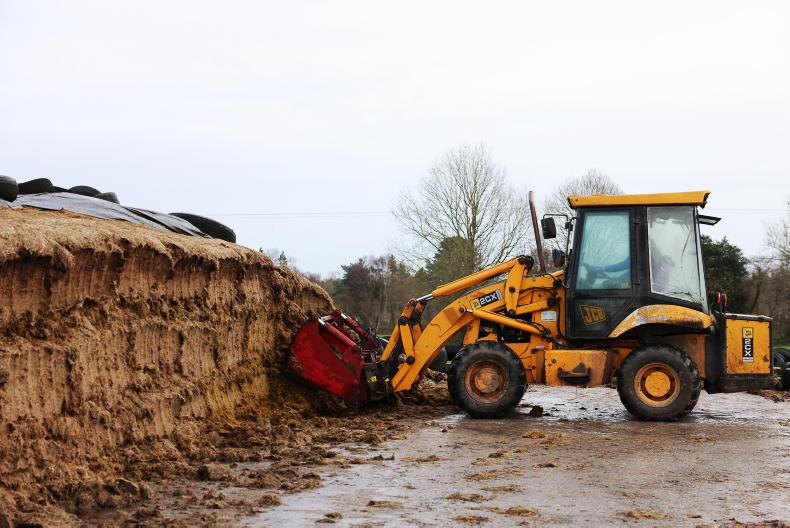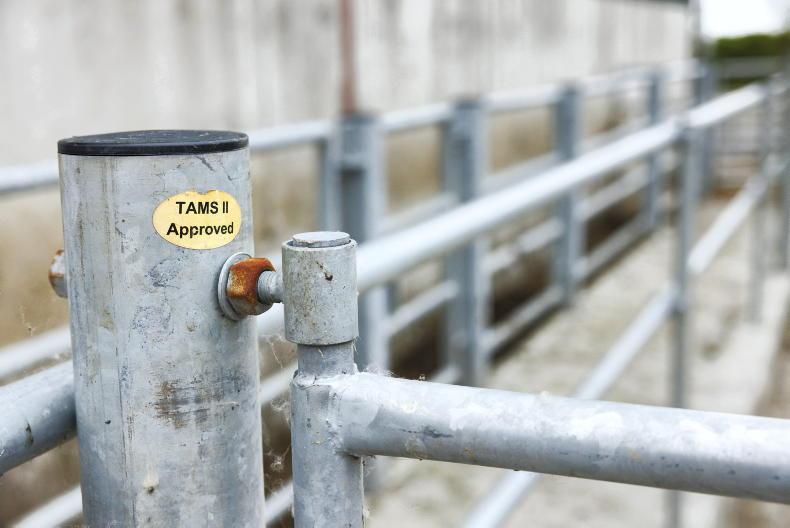Nearly every farm which is feeding a relatively decent volume of concentrates now has a feed silo or meal bin tucked away in some corner.
They’ve knelled a death blow to overhead lofts on parlours with their auger system, while beef and lamb finishers have switched away from bagged feed as well.
The pig and poultry industry have a long-standing usage history of feed silos.
Q-Mac Silos, based in Dungannon, Co Tyrone, are one of the main manufacturers of meal bins on the island of Ireland, with each unit made bespoke to the end users’ requirements, with each bin tailor made to order with no inventory of finished meal bins sitting around their yard.
As part of that bespoke manufacturing process, the company carry a wide variety of optional extras for their meal bins.
Finish and protection
As standard, each bin is hot dip galvanised. The company also offer the option of Magnelis®, which is a galvanised product and has a galvanised appearance but a “much more superior coating with a life span of up to 10 times longer than standard galvanising’’.
Minerals and salts that are used in feeds can have a corrosive effect on silo walls, with the end result being that the feed silos often rot from the inside out.
The company highly recommended Magnelis® for farmers living within a marine salty atmosphere. Aluminium, stainless steel and fibreglass are also material options with the company.
Solano ®Plastisol steel is also an option for farmers wishing to purchase a coloured bin, be it personal preference or to satisfy TAMS requirements.
A galvanised meal bin is pre coated, etch primed and then coated with a plastic leather grain finish on the outside, with three colours available: Juniper Green, Goose Wing Grey and Vandyke Brown.
Weigh cells
Q-Mac can fit weigh cells underneath each leg of the feed silo to accurately measure feed usage and indicate when feed levels are running low.

Fully enclosed silos, with a reinforced 1m wide doorway, is a popular option with farmers locating silos on out blocks.
While sight glasses are installed in many feed silos across manufacturers, uneven settling of feed can give an inaccurate display, showing feed to be either plentiful or in short supply when the opposite might be the case.
The silos can also be fitted with pressure monitors on the legs, which measure exertion on each leg which will then convert this to an accurate weight of feed.
Inspection hatches
This option actually comes standard with Q-Mac silos. A 600mm x 600mm access door is installed in the base cone of the feed silo for personal access, for repairs or cleaning.
Q-Mac advises customers to perform an annual cleaning of feed silos to remove any caked-on concentrates.
A vision panel, where a clear removable hatch is fitted into the base cone, can also be used for access for annual cleaning.
Auger/bagged chute options
Q-Mac recommends that nearly all silos fitted with augers be fitted with a bagging chute to allow for feed to be collected from the silo for sick animals etc.
The firm has several options to choose in the line of augers, with an optional extra being an anti-bridge vibrator.
The anti-bridge vibrator can be fitted to a reinforced panel, which is normally wired to an auger to vibrate the silo when the auger is working.
This helps to keep meal flowing when emptying to reduce bridging in a silo.
Fully enclosed silos
While not a major seller for the company, with less than 10% of silos fitted with this option, fully enclosed silos are an option that farmers purchasing silos for out farms may opt for.
The enclosed room allows as a secure storage area while also preventing any theft or tampering with the silo and enclosed feed.
Reinforced doors are fitted which are 1m wide to allow access with a large wheelbarrow for feeding out.
Diet feeder access
The company offers a range of options regarding filling diet feeders from silos. A centre discharge fitted with an auger can be selected, while raised free standing silos are also an option.
A drive through gantry can also be manufactured which allows tractors and diet feeders to park directly under the meal bin, avoiding the need for an auger.
Nearly every farm which is feeding a relatively decent volume of concentrates now has a feed silo or meal bin tucked away in some corner.
They’ve knelled a death blow to overhead lofts on parlours with their auger system, while beef and lamb finishers have switched away from bagged feed as well.
The pig and poultry industry have a long-standing usage history of feed silos.
Q-Mac Silos, based in Dungannon, Co Tyrone, are one of the main manufacturers of meal bins on the island of Ireland, with each unit made bespoke to the end users’ requirements, with each bin tailor made to order with no inventory of finished meal bins sitting around their yard.
As part of that bespoke manufacturing process, the company carry a wide variety of optional extras for their meal bins.
Finish and protection
As standard, each bin is hot dip galvanised. The company also offer the option of Magnelis®, which is a galvanised product and has a galvanised appearance but a “much more superior coating with a life span of up to 10 times longer than standard galvanising’’.
Minerals and salts that are used in feeds can have a corrosive effect on silo walls, with the end result being that the feed silos often rot from the inside out.
The company highly recommended Magnelis® for farmers living within a marine salty atmosphere. Aluminium, stainless steel and fibreglass are also material options with the company.
Solano ®Plastisol steel is also an option for farmers wishing to purchase a coloured bin, be it personal preference or to satisfy TAMS requirements.
A galvanised meal bin is pre coated, etch primed and then coated with a plastic leather grain finish on the outside, with three colours available: Juniper Green, Goose Wing Grey and Vandyke Brown.
Weigh cells
Q-Mac can fit weigh cells underneath each leg of the feed silo to accurately measure feed usage and indicate when feed levels are running low.

Fully enclosed silos, with a reinforced 1m wide doorway, is a popular option with farmers locating silos on out blocks.
While sight glasses are installed in many feed silos across manufacturers, uneven settling of feed can give an inaccurate display, showing feed to be either plentiful or in short supply when the opposite might be the case.
The silos can also be fitted with pressure monitors on the legs, which measure exertion on each leg which will then convert this to an accurate weight of feed.
Inspection hatches
This option actually comes standard with Q-Mac silos. A 600mm x 600mm access door is installed in the base cone of the feed silo for personal access, for repairs or cleaning.
Q-Mac advises customers to perform an annual cleaning of feed silos to remove any caked-on concentrates.
A vision panel, where a clear removable hatch is fitted into the base cone, can also be used for access for annual cleaning.
Auger/bagged chute options
Q-Mac recommends that nearly all silos fitted with augers be fitted with a bagging chute to allow for feed to be collected from the silo for sick animals etc.
The firm has several options to choose in the line of augers, with an optional extra being an anti-bridge vibrator.
The anti-bridge vibrator can be fitted to a reinforced panel, which is normally wired to an auger to vibrate the silo when the auger is working.
This helps to keep meal flowing when emptying to reduce bridging in a silo.
Fully enclosed silos
While not a major seller for the company, with less than 10% of silos fitted with this option, fully enclosed silos are an option that farmers purchasing silos for out farms may opt for.
The enclosed room allows as a secure storage area while also preventing any theft or tampering with the silo and enclosed feed.
Reinforced doors are fitted which are 1m wide to allow access with a large wheelbarrow for feeding out.
Diet feeder access
The company offers a range of options regarding filling diet feeders from silos. A centre discharge fitted with an auger can be selected, while raised free standing silos are also an option.
A drive through gantry can also be manufactured which allows tractors and diet feeders to park directly under the meal bin, avoiding the need for an auger.










SHARING OPTIONS